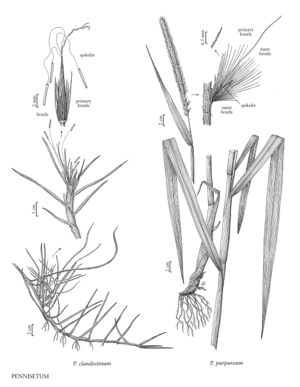Difference between revisions of "Pennisetum purpureum"
FNA>Volume Importer |
imported>Volume Importer |
||
| (8 intermediate revisions by 2 users not shown) | |||
| Line 4: | Line 4: | ||
|publications= | |publications= | ||
|common_names=Elephant grass | |common_names=Elephant grass | ||
| + | |special_status={{Treatment/ID/Special_status | ||
| + | |code=I | ||
| + | |label=Introduced | ||
| + | }} | ||
|basionyms= | |basionyms= | ||
|synonyms= | |synonyms= | ||
| Line 17: | Line 21: | ||
-->{{Treatment/Body | -->{{Treatment/Body | ||
|distribution=Puerto Rico;Tex.;Virgin Islands;Calif.;Pacific Islands (Hawaii);Fla. | |distribution=Puerto Rico;Tex.;Virgin Islands;Calif.;Pacific Islands (Hawaii);Fla. | ||
| − | |discussion=<p>Pennisetum purpureum is native to Africa but now grows in tropical areas throughout the world, frequently becoming naturalized. It is grown as an ornamental in the Flora region, and, less commonly, for forage.</p> | + | |discussion=<p><i>Pennisetum purpureum</i> is native to Africa but now grows in tropical areas throughout the world, frequently becoming naturalized. It is grown as an ornamental in the Flora region, and, less commonly, for forage.</p> |
|tables= | |tables= | ||
|references= | |references= | ||
| Line 26: | Line 30: | ||
-->{{#Taxon: | -->{{#Taxon: | ||
name=Pennisetum purpureum | name=Pennisetum purpureum | ||
| − | |||
|authority=Schumach. | |authority=Schumach. | ||
|rank=species | |rank=species | ||
| Line 33: | Line 36: | ||
|basionyms= | |basionyms= | ||
|family=Poaceae | |family=Poaceae | ||
| + | |illustrator=Linda A. Vorobik | ||
| + | |illustration copyright=Utah State University | ||
|distribution=Puerto Rico;Tex.;Virgin Islands;Calif.;Pacific Islands (Hawaii);Fla. | |distribution=Puerto Rico;Tex.;Virgin Islands;Calif.;Pacific Islands (Hawaii);Fla. | ||
|reference=None | |reference=None | ||
|publication title= | |publication title= | ||
|publication year= | |publication year= | ||
| − | |special status= | + | |special status=Introduced |
| − | |source xml=https:// | + | |source xml=https://bitbucket.org/aafc-mbb/fna-data-curation/src/200273ad09963decb8fc72550212de541d86569d/coarse_grained_fna_xml/V25/V25_1353.xml |
|subfamily=Poaceae subfam. Panicoideae | |subfamily=Poaceae subfam. Panicoideae | ||
|tribe=Poaceae tribe Paniceae | |tribe=Poaceae tribe Paniceae | ||
Latest revision as of 18:56, 11 May 2021
Plants perennial; sometimes rhizomatous. Culms 2-8 m, erect, pubescent beneath the panicle; nodes glabrous or pubescent. Sheaths glabrous or pubescent; ligules 1.5-5 mm; blades 23-125 cm long, (4)12-40 mm wide, flat, glabrous or pubescent. Panicles terminal, 8-30.5 cm long, (10)30-50 mm wide, fully exerted from the leaf sheaths, erect, golden-yellow to dark purple; rachises terete, pubescent. Fascicles 30-40 per cm, disarticulating at maturity; fascicle axes 0.5-1.5 mm, with 1-5 spikelets; outer bristles 20-63, 1.5-10.3 mm, yellow or purple, scabrous; inner bristles 4-6, 9.1-11.5 mm, yellow or purple, sparsely long-ciliate; primary bristles 13-40 mm, noticeably longer than the other bristles, yellow or purple, scabrous. Spikelets 5.9-7 mm, pedicellate; pedicels of terminal spikelets 0.2-0.4 mm, of other spikelets 1.8-3 mm; lower glumes absent or to 0.8 mm; upper glumes 0.8-3 mm, 0-1-veined; lower florets sterile or staminate; lower lemmas 4-5.3 mm, 3-5(6)-veined; lower paleas 4-4.7 mm; anthers absent or 2.2-3.1 mm, penicillate; upper lemmas 4.5-7 mm, subcoriaceous, shiny, 5-7-veined, acuminate; anthers 2.7-3.6 mm, penicillate. Caryopses 1.8-2.2 mm. 2n = 28.
Distribution
Puerto Rico, Tex., Virgin Islands, Calif., Pacific Islands (Hawaii), Fla.
Discussion
Pennisetum purpureum is native to Africa but now grows in tropical areas throughout the world, frequently becoming naturalized. It is grown as an ornamental in the Flora region, and, less commonly, for forage.
Selected References
None.
